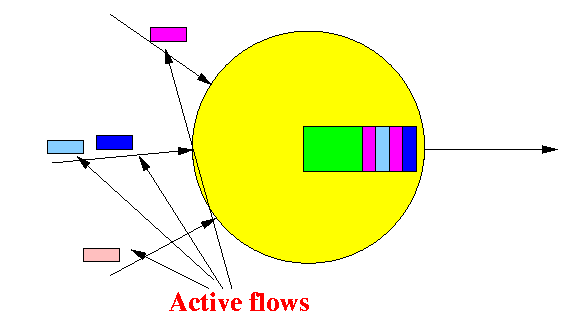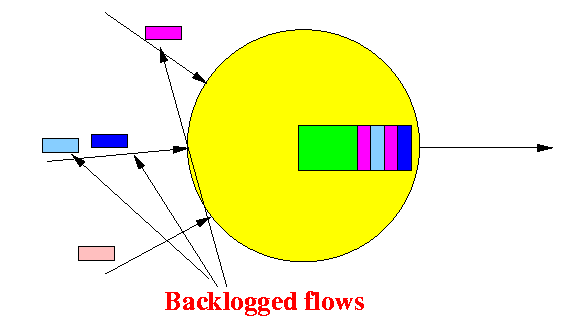- Max-min fairness:
- Is a static definition
- Network connections:
- are some times
idle
- some times
active
- Are established and disconnected
- are some times
idle
- Bottom line:
- max-min fairness is difficult to enforce on network connections....
We need a more practical (easily enforceable) definition of fairness....
- Active Flows:

Note:
- A flow (connection) is
active if it is
sending packets
to a router
- An active flow
may not have packets
buffered at the router
due to
temporal inactivity
Example:
- There are 4 active flows
- But... the flow at the bottom of the figure does not have packets buffered
- There are 4 active flows
- A flow (connection) is
active if it is
sending packets
to a router
- Backlogged Flows:

Note:
- A flow (connection) is backlogged if it has packets buffered at a router
- Work for flow f:
- Wf
(t1, t2) =
work
performed for a flow f
during the
time interval
[ t1, t2 ]
This is the amount of data of flow f transmitted in the interval [ t1, t2 ]
- Wf
(t1, t2) =
work
performed for a flow f
during the
time interval
[ t1, t2 ]
- Fact:
- Active flows
(but not backlogged) that
has no packets
in the buffer of the router
will
not receive any service
- Only backlogged flows will receive service from the router !
- Active flows
(but not backlogged) that
has no packets
in the buffer of the router
will
not receive any service
- Degree of unfairness: Difference in the received service between
backlogged flows:
- Work received
by a flow f
in interval
[t1, t2]:
- Wf (t1, t2)
- Work received
by a flow g
in interval
[t1, t2]:
- Wg (t1, t2)
- Degree of unfairness =
difference in received service
--- i.e.,
work received:
- | Wf (t1, t2) − Wg (t1, t2) |
- Work received
by a flow f
in interval
[t1, t2]:
- Manifestation of
unfairness:
- A method that is fair
will
does not favor
any particular flow....
- A method that is unfair
will
does favor
some flow
over another flow....
- Manifestation of "flavoring
a flow":
- When a method
flavors a flow x,
then the
flow x will receive
more service
- So when a method
flavors a flow f
over a flow g
then:
- | Wf (t1, t2) − Wg (t1, t2) | will increase when the interval [t1, t2] increases
- In other words:
- If a method is unfair, the difference in the received service between two flows will become arbitrarily large when given sufficient time (for the unfair method to operate)
- When a method
flavors a flow x,
then the
flow x will receive
more service
- A method that is fair
will
does not favor
any particular flow....
- A practical definition of "fairness"...
- A transmission method is
fair if:
- | Wf (t1, t2) − Wg (t1, t2) | ≤ some specific constant
for every interval [t1, t2] where both flows f and g are backlogged
- A transmission method is
fair if:
- Note:
- This definition of
fairness allows us to
prove mathematically
that some
packet transmission (scheduling) method
is fair
- We will see some proof in the discussion of the methods...
- This definition of
fairness allows us to
prove mathematically
that some
packet transmission (scheduling) method
is fair
- Weights and reservations:
- The fairness definition
above can be generalized
to given flows different weights
- Traditionally, weights corresponds to (bandwidth) reservations for flows
- The fairness definition
above can be generalized
to given flows different weights
- Reservation rf:
- The reservation rf of flow f is the amount of transmission capacity (bandwidth) reserved for flow f
- Note:
- If a link has
a transmission capacity C
(i.e., C bits per second transmission rate),
then the reservation
cannot exceed C
- In fact, the total reservation
must be not exceed the
link transmission capacity C:
- ∑all flows f rf ≤ C
- If a link has
a transmission capacity C
(i.e., C bits per second transmission rate),
then the reservation
cannot exceed C
- Bandwidth unit:
- Some literature
uses the link capacity C
as unit measure for bandwidth
(I.e., a reservation of 1 means reserve all capacity on the link)
- In these papers,
the reservation rf
is then:
- rf ≤ 1
and,
- ∑all flows f rf ≤ 1
- rf ≤ 1
and,
- Some literature
uses the link capacity C
as unit measure for bandwidth
- Normalized service for flow f:
- The normalized service
performed for a flow f
during the
time interval
[ t1, t1 ]
( wf
(t1, t1) )
is defined as:
Wf(t1,t1) wf(t1,t1) = ---------- ...... (1) rf
- The normalized service
performed for a flow f
during the
time interval
[ t1, t1 ]
( wf
(t1, t1) )
is defined as:
- Significance (meaning) of the normalized service:
- rf =
the amount of
reservation of
flow f
I.e.: rf = the amount of work that flow f is entitled to
- Wf =
the actual amount of
work
received by
flow f
- Ideally:
Wf(t1,t1) wf(t1,t1) = ---------- = 1 (or very close to 1) rffor every flow f
- rf =
the amount of
reservation of
flow f
- Fair service:
- A packet scheduling method is fair if the difference in the normalized service provided to any two flows that are continuously backlogged over any interval [t1,t2] is bounded by some constant.
- In Mathematical terms:
- A scheduling algorithm is fair if:
if f and g are continuously backlogged in [t1,t2], then: ∃ constant c: | wf(t1,t2) - wg(t1,t2) | < c i.e.: | Wf(t1,t2) Wg(t1,t2) | ∃ constant c: | --------- - --------- | < c | rf rg |(This fairness definition was introduced by S. J. Golestani and it is the generally accepted fairness criteria for long-running network connections)
- A scheduling algorithm is fair if:
- Notes:
- The smaller the constant
c, the
smaller the difference
in the obtained (normalized)
service
between 2 flows.
I.e.: The smaller the constant c, the more fair the scheduling algorithm is....
- If the constant c = 0,
then the scheduling algorithm
is perfectly fair !!!
- The smaller the constant
c, the
smaller the difference
in the obtained (normalized)
service
between 2 flows.